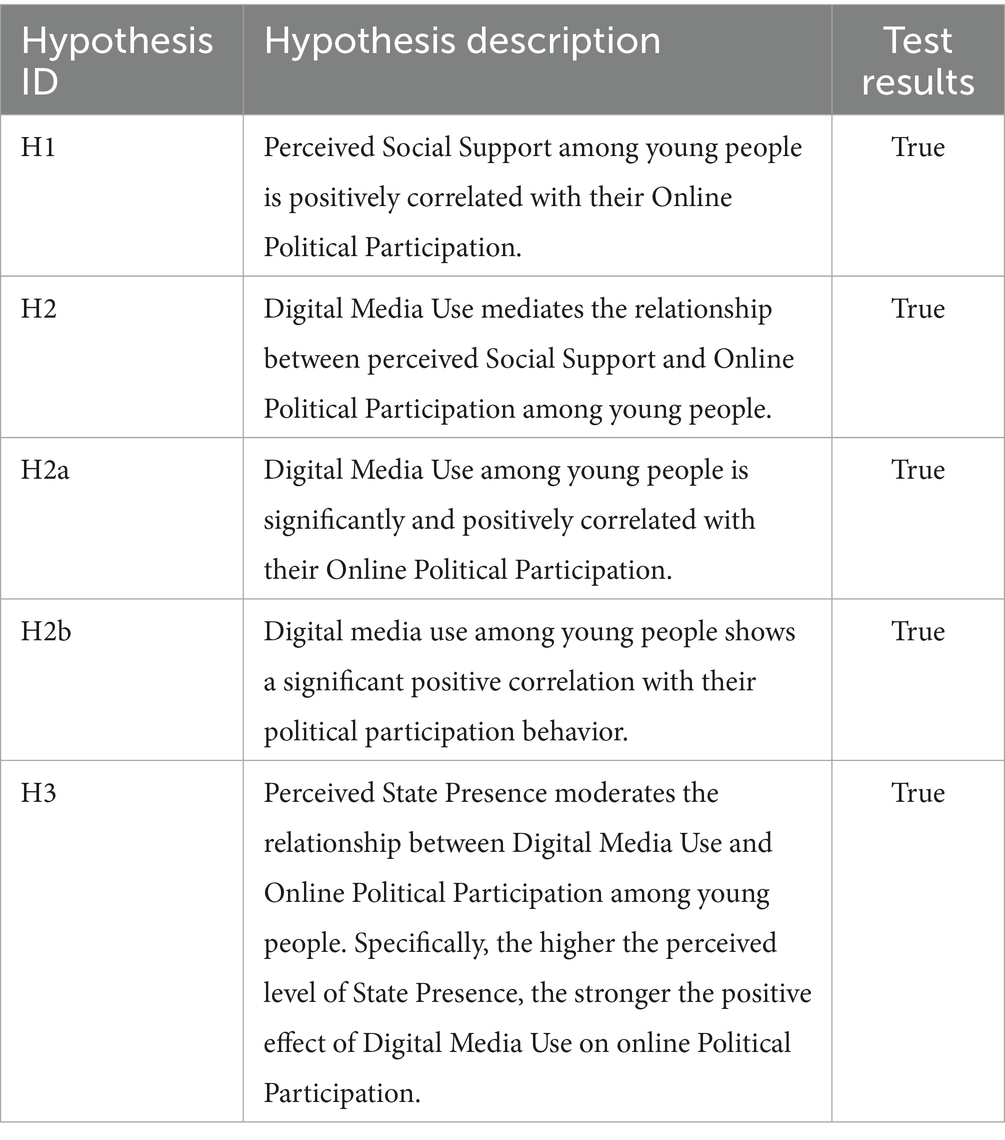Resilience under the chilling effect: how social support and digital media reshape online political participation among Chinese youth – Frontiers

Report on Youth Digital Engagement and its Implications for Sustainable Development Goals in China
Introduction: Youth Civic Engagement and the 2030 Agenda
This report examines the dynamics of online political participation among Chinese youth, framing the analysis within the context of the United Nations Sustainable Development Goals (SDGs). The active engagement of youth is a critical prerequisite for achieving the 2030 Agenda, particularly SDG 16 (Peace, Justice and Strong Institutions), which calls for responsive, inclusive, and participatory decision-making at all levels (SDG 16.7).
In China, digital platforms have become primary channels for youth to access information and express their civic voice. This digital transformation presents a dual potential:
- It can foster a virtuous cycle of engagement, supporting the aims of SDG 16 by providing new avenues for participation.
- Conversely, it can lead to political apathy and polarization, undermining the goal of building inclusive societies.
The Chinese political landscape, characterized by “fragmented authoritarianism,” creates a complex environment. While offline protest is restricted, state leaders encourage certain forms of prosocial participation. However, the pervasive sense of state surveillance online can induce a “chilling effect,” directly challenging the principles of SDG 16.10 (Ensure public access to information and protect fundamental freedoms). In contrast, offline social support from family and community networks is a known motivator for civic action, contributing to social cohesion as envisioned in SDG 11 (Sustainable Cities and Communities).
This study investigates how digital media use and perceived social support jointly shape political participation among Chinese youth, and how state presence moderates this relationship. The analysis aims to clarify the factors that sustain youth political involvement, providing insights relevant to the implementation of the SDGs in a mediated, authoritarian context.
Literature Review: Framing Digital Participation within the SDGs
Online Political Participation and SDG 16
Political participation is a cornerstone of democratic governance and a key indicator for SDG 16. Its definition has evolved to include a wide spectrum of behaviors:
- Traditional Participation: Voting and campaigning.
- Unconventional Participation: Rallies and protests.
- Digital-Era Participation: Creative and personalized online acts, such as podcasts, online petitions, and social media campaigns.
These new forms of engagement are crucial for enabling youth to contribute to public life on their own terms, directly aligning with the target of SDG 16.7. However, the rise of political apathy among some youth poses a significant challenge to building the inclusive institutions central to the 2030 Agenda. The distinction between online and offline participation is increasingly blurred, as online expression often serves as a precursor to real-world action, making the digital sphere a critical arena for fostering civic-mindedness.
The Role of Digital Media in Advancing Sustainable Development
Information and communication technologies (ICT) are recognized as powerful enablers for sustainable development. Digital media use is directly relevant to several SDGs:
- SDG 4 (Quality Education): Digital platforms provide access to information and lifelong learning opportunities.
- SDG 16 (Peace, Justice and Strong Institutions): Digital media serve as platforms for self-expression, organization, and coordination among citizens, facilitating accountability and public discourse.
- SDG 10 (Reduced Inequalities): Online channels can empower marginalized groups by giving them a platform to voice their concerns.
Research shows a strong, albeit complex, link between digital media use and political behavior. While some studies suggest that digital media can foster cynicism and reduce participation, others find a positive correlation. This report investigates the pathway from social support to political participation, with digital media use acting as a critical mediator, to better understand how technology can be leveraged to support the SDGs.
Governance, State Presence, and Fundamental Freedoms (SDG 16.10)
The concept of “Fragmented Authoritarianism” describes a political system where state power is dispersed, leading to inconsistencies in governance. In China, this means that while the central government enforces strict information controls, local authorities may sometimes tolerate or even support grassroots activity.
This environment gives rise to two countervailing forces affecting civic engagement:
- The Chilling Effect: Perceived state surveillance can lead to self-censorship, directly undermining SDG 16.10, which seeks to protect fundamental freedoms. This psychological restraint discourages open expression and collective action.
- Social Support: Conversely, support from local communities and peer networks can act as a buffer, encouraging participation. This dynamic is linked to SDG 11, which emphasizes inclusive and resilient communities, and can sometimes manifest as “entrepreneurial censorship” where local governments accommodate civic movements.
Research Framework and Methodology
Study Design and Hypotheses
This study utilized an online questionnaire survey of 6,855 youths (aged 18-40) in Guangdong Province, China. The research framework examines the interrelations among perceived social support, digital media use, state presence, and online political participation. The focus on youth is critical, as they are key agents of change for the 2030 Agenda for Sustainable Development.
The following hypotheses were tested:
- H1: Perceived social support is positively correlated with online political participation.
- H2: Digital media use mediates the relationship between social support and online political participation.
- H3: Perceived state presence moderates the relationship between digital media use and online political participation.
Measurement of Key Variables in the Context of SDGs
- Perceived Social Support: Measured satisfaction with infrastructure, policy support, and community environment, reflecting indicators relevant to SDG 11 and the enabling conditions for participation under SDG 16.
- Digital Media Use: Measured the frequency of using various platforms for information-seeking, a proxy for access to information (SDG 16.10) and digital literacy (SDG 4).
- State Presence: Measured awareness of and support for state ideology and internet governance, gauging the perceived environment for fundamental freedoms (SDG 16.10).
- Online Political Participation: Measured the frequency of expressive acts, online activism, and petitioning, capturing behaviors central to participatory decision-making (SDG 16.7).
Results: Findings on Youth Engagement and Sustainable Development
Descriptive Statistics
- Social Support: Youth reported moderate overall satisfaction (M=2.88). While satisfaction with family and community was relatively high, satisfaction with public infrastructure and policy support was lower, indicating gaps in achieving the comprehensive community well-being targeted by SDG 11.
- Digital Media Use: Information-seeking behaviors were generally high (M=3.17), confirming that digital platforms are a primary source of information for youth.
- State Presence: Perceived state presence was high (M=3.29), with strong support for state-led internet governance. This highlights the salience of state control as a factor influencing the exercise of fundamental freedoms under SDG 16.10.
- Online Political Participation: Overall engagement was relatively low (M=2.30), with online activism being the most common form. This suggests that while youth are online, their engagement in civic action is infrequent, posing a challenge for achieving the participatory goals of SDG 16.
Structural Equation Modeling Results
The analysis confirmed the proposed moderated mediation model:
- Mediation Confirmed (H2): Digital media use was found to be a significant partial mediator. Social support positively influences digital media use, which in turn positively influences online political participation. This pathway is crucial for converting social capital into civic action.
- Moderation Confirmed (H3): Perceived state presence significantly moderated the relationship.
- Higher state presence was associated with lower overall participation, confirming a “chilling effect” that acts as a barrier to achieving SDG 16.
- However, state presence also strengthened the positive effect of digital media use on participation. At high levels of state presence, the conversion of digital media use into political action increased, revealing a paradoxical “empowering effect” under specific conditions.
Discussion and Implications for the Sustainable Development Goals
The Paradoxical Impact of State Presence on SDG 16
The findings present a nuanced picture of civic engagement that complicates linear models of digital authoritarianism. The “chilling effect” of state surveillance is a clear impediment to fostering the open, participatory societies envisioned in SDG 16. It suppresses the free expression necessary for holding institutions accountable and ensuring responsive governance.
However, the paradoxical finding that state presence can sometimes amplify activism among highly supported youth highlights the complex reality of “fragmented authoritarianism.” When social solidarity is strong, state monitoring may not just intimidate but can also catalyze counter-mobilization. This suggests that the path to achieving SDG 16 in such contexts is not straightforward and depends heavily on the strength of community-level social support, a key component of SDG 11.
Redefining Political Participation for the Digital Age
This report challenges the “clicktivism” critique, which dismisses online acts as superficial. In a context where offline protest is restricted, digitally networked participation—including expressive acts like sharing memes or posting comments—constitutes a meaningful form of political engagement. These behaviors contribute to collective awareness and public discourse, which are essential for advancing the 2030 Agenda. To properly measure progress on SDG 16.7, it is vital to recognize this broad spectrum of online behaviors as legitimate and significant forms of participation.
Conclusion and Policy Implications for the 2030 Agenda
Youth civic engagement in China is shaped by a dynamic interplay between the encouragement of social networks, the tools of digital media, and the constraints of state control. To advance the Sustainable Development Goals, particularly SDG 16, policy efforts should focus on:
- Fostering Safe and Inclusive Digital Spaces: Recognizing the value of online participation while working to mitigate the “chilling effect” of surveillance is crucial for protecting fundamental freedoms (SDG 16.10) and promoting constructive public dialogue.
- Strengthening Community and Social Support: Investing in offline community infrastructure and social networks (SDG 11) is essential, as these provide the foundation of support that empowers youth to engage civically, both online and offline. This can also help reduce inequalities in political voice (SDG 10).
- Promoting Digital Literacy: Enhancing youth’s ability to use digital tools effectively and safely for information and engagement is a key component of Quality Education (SDG 4) that directly supports their capacity for civic action.
Future research should continue to explore these dynamics, particularly in the post-COVID-19 era, to understand the evolving landscape of youth participation and its long-term implications for achieving a sustainable and inclusive future.
Analysis of Sustainable Development Goals in the Article
1. Which SDGs are addressed or connected to the issues highlighted in the article?
-
SDG 16: Peace, Justice and Strong Institutions
- The article’s central theme is the political participation of youth, their ability to influence government decision-making, and their interaction with state institutions. It directly examines concepts of governance, accountability, access to information, and fundamental freedoms within the context of China’s “fragmented authoritarianism.” The discussion on state surveillance and the “chilling effect” on expression is highly relevant to this goal.
-
SDG 9: Industry, Innovation and Infrastructure
- The article extensively discusses the role of “digital platforms,” “social media,” and “Information and Communication Technologies (ICT)” as the primary infrastructure for modern political engagement. It highlights how Chinese youth are “permanently online and connected,” underscoring the importance of digital infrastructure (Target 9.c) in facilitating civic action and information dissemination.
-
SDG 10: Reduced Inequalities
- The study focuses on the political inclusion and empowerment of a specific demographic group: youth. By analyzing the factors that enable or hinder their participation, the article addresses the core of Target 10.2, which aims to promote the political inclusion of all, irrespective of age. The inclusion of `hukou` (household registration) as a demographic variable also points to underlying social inequalities.
-
SDG 11: Sustainable Cities and Communities
- The article touches upon community-level factors, measuring satisfaction with “Basic Public Infrastructure,” “Community and Neighborhood,” and “Social Services.” It also notes that “local governments may sometimes accommodate or even support grassroots political activity,” which relates to participatory management and planning in human settlements.
-
SDG 3: Good Health and Well-being
- The study measures “Well-being” as a component of social support and notes that its perceived levels are “comparatively low among youth.” It also discusses how social support from family, friends, or community can alleviate stress, connecting directly to the promotion of mental health and well-being.
2. What specific targets under those SDGs can be identified based on the article’s content?
-
Under SDG 16 (Peace, Justice and Strong Institutions):
- Target 16.7: Ensure responsive, inclusive, participatory and representative decision-making at all levels. The article is fundamentally about this target, as it investigates how youth use digital media to “attempt to influence government decision-making” and engage in various forms of “online political participation.”
- Target 16.10: Ensure public access to information and protect fundamental freedoms, in accordance with national legislation and international agreements. This target is addressed from two angles. First, the article examines how digital media provides “crucial channels for continuous political information.” Second, it analyzes the constraints on fundamental freedoms through “enhanced Internet censorship” and the psychological “chilling effect” of state surveillance, which causes individuals to “self-censor.”
- Target 16.6: Develop effective, accountable and transparent institutions at all levels. The theory of “fragmented authoritarianism” described in the article, where state power is dispersed and local governments sometimes accommodate civic activity, is a direct analysis of institutional effectiveness and accountability in a specific political context.
-
Under SDG 9 (Industry, Innovation and Infrastructure):
- Target 9.c: Significantly increase access to information and communications technology and strive to provide universal and affordable access to the Internet. The article’s premise that “Chinese youth today are permanently online and connected” and its measurement of the usage frequency of various digital media applications (WeChat, Weibo, etc.) directly relate to the widespread access and adoption of ICT.
-
Under SDG 10 (Reduced Inequalities):
- Target 10.2: By 2030, empower and promote the social, economic and political inclusion of all, irrespective of age… The study’s focus on “youth involvement in both online and offline public affairs” and the factors shaping their “political participation” is a direct examination of the political inclusion of the youth demographic.
3. Are there any indicators mentioned or implied in the article that can be used to measure progress towards the identified targets?
-
For Target 16.7 (Participatory Decision-Making):
- Indicator: The “Online Political Participation Behavior” scale. The article explicitly measures the frequency of 12 specific behaviors, including “Publicly sharing information related to public affairs,” “Organizing collective action and protest on social issues,” “Online donating,” and “Participating in online discussions.” These metrics serve as direct indicators of the level and nature of youth participation in public life.
-
For Target 16.10 (Access to Information and Fundamental Freedoms):
- Indicator 1: The “State Presence” scale. This scale measures perceptions of surveillance and state control, such as agreement with “State participation in internet information governance” and “State enhancement of ideological propaganda.” It functions as an indicator for the “chilling effect” on freedom of expression.
- Indicator 2: The “Digital Media Use” scale for information-seeking. The article measures the frequency of behaviors like “following local policy announcements via digital media” and “monitoring local social development through digital media,” which can be used to quantify public access to information.
-
For Target 9.c (Access to ICT):
- Indicator: The “Digital Media Use” scale for platform usage. The study measures the frequency of use for seven types of digital media, including WeChat, Sina Weibo, news platforms, and short-video platforms. This provides a granular indicator of ICT adoption and engagement beyond simple access.
-
For Target 10.2 (Political Inclusion):
- Indicator: The overall rate of online political participation among the youth cohort (ages 18-40). The article finds that overall engagement was “below the midpoint (M = 2.30),” providing a baseline measurement for the political inclusion of this age group. The collection of demographic data (gender, age, hukou) allows for disaggregated analysis of inclusion.
4. Table of SDGs, Targets, and Indicators
| SDGs | Targets | Indicators Identified in the Article |
|---|---|---|
| SDG 16: Peace, Justice and Strong Institutions |
16.7: Ensure responsive, inclusive, participatory and representative decision-making at all levels.
16.10: Ensure public access to information and protect fundamental freedoms. 16.6: Develop effective, accountable and transparent institutions. |
– Frequency of online political participation behaviors (e.g., sharing public affairs info, organizing collective action, online petitions, online donating), measured on a 5-point Likert scale.
– Level of agreement with statements measuring “State Presence” (e.g., “State participation in internet information governance”), indicating the perceived “chilling effect” on freedom of expression. – Frequency of information-seeking behaviors (e.g., “following local policy announcements,” “monitoring local social development”). – Analysis of “fragmented authoritarianism” as a model for institutional responsiveness. |
| SDG 9: Industry, Innovation and Infrastructure | 9.c: Significantly increase access to information and communications technology and strive to provide universal and affordable access to the Internet. | – Frequency of use of specific digital media platforms (WeChat, Sina Weibo, Zhihu, news platforms, short-video platforms, etc.), measured on a 5-point Likert scale. |
| SDG 10: Reduced Inequalities | 10.2: Empower and promote the social, economic and political inclusion of all, irrespective of age… | – Measurement of online political participation specifically for the youth demographic (ages 18-40). – Collection of demographic data (gender, age, hukou) allowing for disaggregated analysis of political inclusion. |
| SDG 11: Sustainable Cities and Communities | 11.3: Enhance inclusive and sustainable urbanization and capacity for participatory… human settlement planning and management. | – Satisfaction scores for “Basic Public Infrastructure,” “Governmental Policy Support,” and “Social Services” at the community level. |
| SDG 3: Good Health and Well-being | 3.4: By 2030, reduce by one third premature mortality from non-communicable diseases through prevention and treatment and promote mental health and well-being. | – Measurement of perceived “Well-being” among youth. – Measurement of “Perceived Social Support” from family and community as a factor that alleviates stress. |
Source: frontiersin.org

What is Your Reaction?
 Like
0
Like
0
 Dislike
0
Dislike
0
 Love
0
Love
0
 Funny
0
Funny
0
 Angry
0
Angry
0
 Sad
0
Sad
0
 Wow
0
Wow
0


















































































